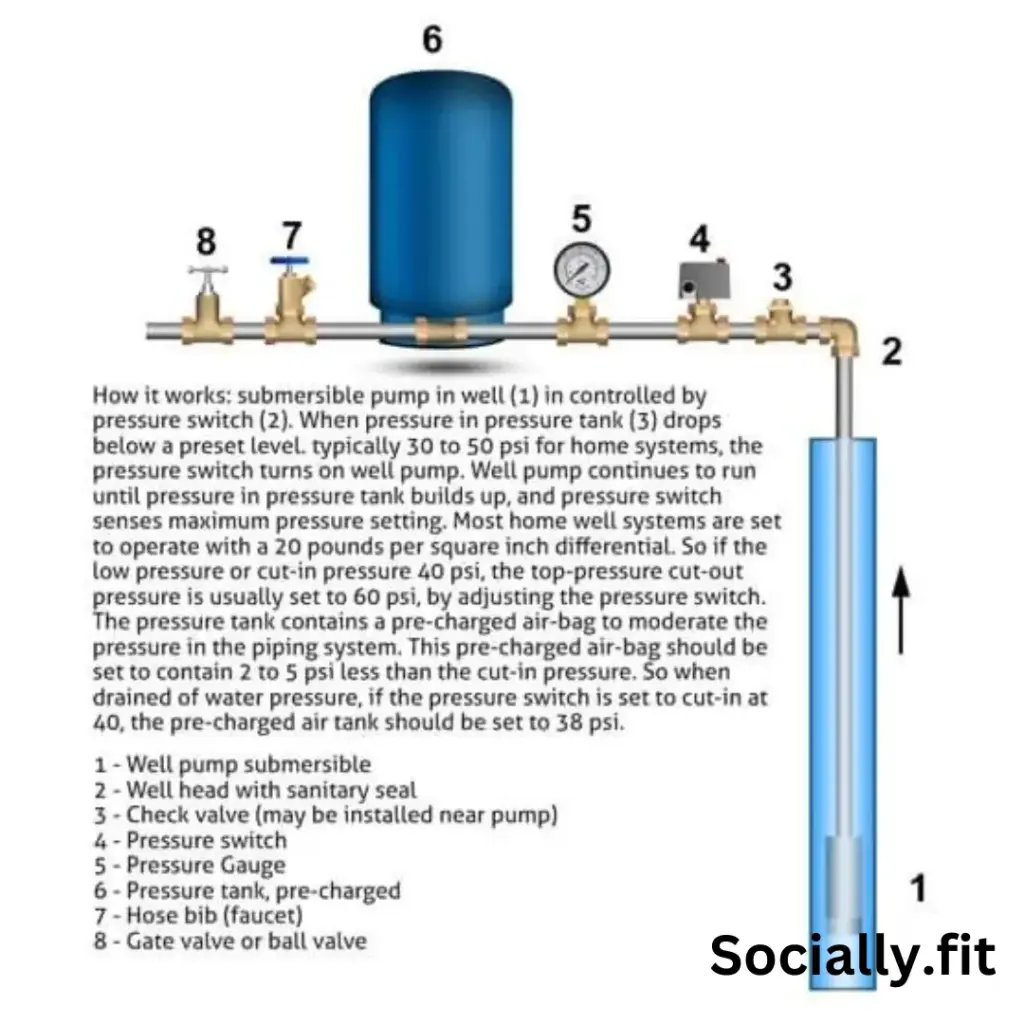Unlocking the Depths: How does Well Water Work!
Introduction

Concealed beneath the Earth’s surface, well water holds the status of a valuable treasure, serving as a crucial source of fresh water for centuries. Providing self-sufficiency and independence to numerous households as an alternative to municipal water supplies, well water systems have played a significant role in water access. In this comprehensive guide, we will venture into the depths to unveil the mysteries surrounding well water.
This exploration will encompass its origins, delve into the intricacies of well drilling, explore the essential components of a well system, and highlight the myriad advantages it offers to homeowners.
How Does Well Water Work?
I. The Origins of Well Water

A. Natural Reservoirs: Understanding Aquifers.
Well water finds its source in underground reservoirs known as aquifers. Permeable rocks or sediments, such as sand, gravel, or limestone, commonly constitute geological formations that have the ability to store and transmit groundwater. Functioning as natural filters for rainwater or melted snow that permeates the Earth’s surface, these formations enable water to accumulate within the pore spaces of the aquifer, creating a subterranean reservoir.
The depth and characteristics of aquifers exhibit considerable variation, impacting both the quality and quantity of well water. While shallow aquifers, located close to the surface, may provide rapid access to water, they are more prone to contamination. In contrast, deeper aquifers typically yield cleaner water but necessitate more extensive drilling efforts. Consequently, comprehending the geological features of aquifers is essential for assessing a well’s potential to serve as a sustainable and secure water source.
B. Formation of Wells: Geological Processes.
Geologists employ strategic well-drilling methods to gain access to underground aquifers, utilizing advanced techniques and their geological expertise. A meticulous geological survey initiates this process, identifying potential aquifers and thoroughly assessing their characteristics. Through the analysis of soil composition, rock formations, and the depth of the water table, geologists adeptly pinpoint the most promising locations for the subsequent drilling of wells.
Once a suitable site is identified, the drilling process commences. Specialized equipment, such as rotary or percussion drills, is utilized to bore into the Earth’s surface. Progressing deeper, the drill encounters layers of soil, rock, and sediment. The final well depth is determined by the targeted aquifer and the required water quality. Following the drilling, a well casing is installed to prevent collapse and safeguard the water from external contaminants.
For homeowners considering well water systems, understanding these geological processes is crucial. It empowers them to make informed decisions about well placement, depth, and potential water quality.
How Does Well Water Work?
II. Well Drilling: Unearthing Liquid Gold

A. Preliminary Assessments: Site Selection and Testing.
The journey to access well water begins with meticulous preliminary assessments. Geological surveys are conducted to identify the most suitable drilling site. Geologists evaluate factors such as soil composition, rock types, and the depth of the water table to pinpoint potential aquifers. Additionally, local regulations and permits must be considered to ensure compliance with environmental standards.
Before drilling commences, on-site testing is performed to analyze the water quality and quantity. This involves extracting samples to assess factors like pH levels, mineral content, and potential contaminants. Understanding these parameters helps determine the appropriate depth for the well and the necessary water treatment measures.
B. The Drilling Process: Techniques and Equipment.
Executing the drilling process is a complex operation demanding specialized equipment and the expertise of skilled professionals. Various drilling techniques, such as rotary and percussion drilling, are commonly employed to achieve successful results.
- Rotary Drilling: This method involves a rotary bit attached to the end of a rotating drill pipe. As the bit rotates, it breaks through the ground, creating a borehole. Circulating mud or drilling fluids carries away cuttings and maintains stability during rotary drilling, which proves effective in various geological formations and is often employed for deeper wells.
- In the percussion drilling technique, a cable connects a substantial bit that repetitively lifts and drops, effectively pulverizing the rock or soil. To prevent caving and cool the bit, water is injected into the borehole. This method proves particularly suitable for shallow wells situated in softer formations.
C. Well Casing: Ensuring Structural Integrity.
To ensure the well remains stable and to uphold water quality standards, a well casing is implemented subsequent to drilling. Composed of materials such as steel, PVC, or concrete, this casing extends from the surface to the bottom of the borehole. Its primary functions include offering structural support and acting as a barrier to prevent soil, debris, or contaminants from infiltrating the well.
The choice of casing material depends on factors such as the depth of the well, the geological composition, and local regulations. Steel casing is common for deep wells, offering strength and durability, while PVC is preferred for shallower wells due to its corrosion resistance.
Understanding the intricacies of well drilling, from site selection to casing installation, is essential for homeowners embarking on the journey to harness their own liquid gold beneath the Earth’s surface.
How Does Well Water Work?
III. Components of a Well System

A. Pumping Mechanisms: Submersible vs. Jet Pumps.
At the heart of every well water system lies its pumping mechanism, a crucial component responsible for lifting water from the underground reservoir to the surface. There are two prevalent types of pumps commonly employed in well systems: submersible pumps and jet pumps.
- Submersible pumps operate by submerging directly into the well, usually below the water level. Their efficiency and quiet operation make them popular. They utilize impellers, driven by an electric motor, to push water to the surface. Submersible pumps are a preferred choice for deeper wells due to their ability to handle higher lifting capacities.
- Jet Pumps: Unlike submersible pumps, jet pumps are located above ground and draw water from the well to the surface. They work by creating a vacuum that lifts water through a suction pipe. Jet pumps are further classified into shallow well and deep well jet pumps, depending on the depth of the water table. While jet pumps may be more accessible for maintenance, they are generally less efficient than submersible pumps.
B. Pressure Tanks: Maintaining a Consistent Flow.
Playing a crucial role in regulating water flow and maintaining consistent pressure within a well system, pressure tanks are integral components. As water is pumped into the pressure tank, it compresses the air inside, creating pressure. When a tap is opened, the pressurized air expels the water, ensuring a steady and controlled flow.
The size of the pressure tank is determined by both the well’s pumping capacity and the household’s water demand. Proper sizing is essential to prevent rapid cycling of the pump, thereby reducing wear and energy consumption. Furthermore, pressure tanks are equipped with pressure switches that signal the pump to start or stop based on water demand, contributing significantly to the overall efficiency of the system.
C. Control Systems: Automation and Monitoring.
Contemporary well water systems frequently incorporate advanced control systems, seamlessly automating the operation and monitoring of the entire system. These sophisticated systems encompass electronic controls, sensors, and monitoring devices, effectively overseeing pump operation, water pressure, and overall well performance.
Automation allows for better efficiency by optimizing pump usage and preventing unnecessary cycling. Some advanced systems may have remote monitoring capabilities that allow homeowners to track the system’s performance and receive alerts in case of issues. Such control systems enhance the overall reliability of the well water system, providing users with real-time information and control over their water supply.
D. Water Treatment: Ensuring Quality.
Ensuring the quality of well water is paramount for the health and safety of consumers. Moreover, well systems integrate water treatment components to address potential contaminants and enhance water quality.
- Installing filters is essential to remove sediment, sand, and other particulate matter, preventing them from entering the plumbing system and causing damage.
- In areas with hard water, we use water softeners to reduce the concentration of minerals, such as calcium and magnesium, which can cause scale buildup in pipes and appliances.
- Implementing chlorination or other disinfection methods is essential for eliminating bacteria, viruses, and other microorganisms present in well water.
Understanding these components is crucial for homeowners managing their well water systems, as it allows them to make informed decisions, troubleshoot issues, and ensure the efficient and reliable operation of their well.
How Does Well Water Work?
IV. Advantages of Well Water Systems:

- Cost Efficiency:
- Long-term cost savings compared to municipal water supplies.
- Exemption from monthly water bills, meter charges, and additional fees.
- Predictable maintenance and repair costs.
- Independence and Reliability:
- Continuous and consistent water supply, especially in rural or remote areas.
- Unaffected by municipal water service interruptions.
- Reliable operation during power outages or emergencies.
- Environmental Impact:
- Smaller environmental footprint compared to centralized municipal water supplies.
- Elimination of extensive water treatment and distribution infrastructure.
- Promotes responsible water usage and conservation practices.
Conclusion: Well water systems offer homeowners economic benefits, independence, reliability, and environmental sustainability. While there are initial installation costs and maintenance considerations, the long-term advantages contribute to a self-sufficient and eco-friendly water supply solution.
How Does Well Water Work?
V. Disadvantages of Well Water Systems:

Initial Installation Costs and Complexity:
Higher upfront expenses for well drilling, casing, and pump installation.
Complex geological assessments and regulatory compliance may contribute to overall costs.
Maintenance and Potential Contamination Risks:
Regular maintenance is essential for optimal performance. However, without proper upkeep, components such as pumps and filtration systems may fail, consequently posing contamination risks. Furthermore, wells are susceptible to various contaminants, underscoring the need for regular water testing and monitoring.
Limited Water Quantity and Drought Vulnerability:
The aquifer’s water storage, susceptible to seasonal variations and drought conditions, influences reliance. Reduced well yields during droughts or excessive water extraction. Well owners need to be mindful of their well’s capacity and implement water conservation practices during dry periods.
Potential for Hard Water and Mineral Content:
Certain geological formations can give rise to well water characterized by high mineral content, commonly referred to as hard water. Consequently, the presence of minerals such as calcium and magnesium in the water can lead to scaling in pipes and appliances, ultimately diminishing their efficiency. In order to address the adverse effects of hard water, the implementation of water softeners may become necessary, thereby incurring an additional cost.
Conclusion: Awareness of these disadvantages allows prospective well owners to make informed decisions, considering factors such as budget, maintenance commitment, and water quality considerations. Regular monitoring and proper maintenance can help mitigate many of these challenges, ensuring a reliable and sustainable well water supply.
How Does Well Water Work?
VI. Maintenance and Troubleshooting Tips for Well Water Systems:

Ensuring the optimal performance, water quality, and longevity of a well water system is essential. By conducting regular inspections and taking proactive measures, issues can be prevented and concerns addressed promptly. Here are ten tips for effective maintenance and troubleshooting:
Regular Well Inspections:
- Schedule annual inspections by a professional well service provider.
- Check for signs of corrosion, leaks, or structural issues in the well casing.
Water Quality Testing:
- Conduct periodic water quality tests to detect contaminants.
- Test for bacteria, nitrates, and other potential pollutants to ensure safe drinking water.
Monitor Water Levels:
- Keep an eye on the water levels in the well to identify any sudden or gradual changes.
- Drastic drops in water levels may indicate issues such as pump failure or well depletion.
Inspect the Pump System:
- Regularly check the pump, pressure tank, and associated components.
- Ensure the pressure switch is functioning correctly to prevent pump overuse.
Check for Unusual Noises:
- Listen for unusual noises during pump operation.
- Pump issues manifest through grinding or knocking sounds, requiring prompt attention.
Inspect Electrical Components:
- Inspect the electrical connections and wiring for any indications of wear or damage.
- Verify that the pump motor is drawing the appropriate amount of current.
Monitor Water Flow:
- Observe water flow from faucets to identify any sudden changes or reductions.
- Inconsistent flow may indicate issues with the pump or pressure tank.
Inspect Filtration Systems:
- Regularly clean or replace filters to prevent clogging and maintain water quality.
- Check for sediment buildup in the well, which can affect pump efficiency.
Address Plumbing Leaks Promptly:
- Repair any leaks in the plumbing system promptly to prevent water loss and pressure issues.
- Leaks can also introduce contaminants into the well water.
Know the Signs of Contamination:
- Be aware of changes in water color, taste, or odor, as these may indicate contamination.
- Address any signs of contamination immediately, and consult with a water treatment professional if needed.
How Does Well Water Work?
Conclusion:
In conclusion, well water systems serve as a testament to humanity’s adeptness in harnessing nature’s resources for sustainable living. Furthermore, a comprehensive understanding of how well water operates empowers homeowners to make informed choices regarding their water supply. By delving into the intricacies of well drilling, system components, and maintenance, individuals can unlock the potential of the hidden reservoir beneath their feet. Consequently, this ensures a reliable, cost-effective, and environmentally friendly water source for generations to come.
Click here to learn more about weight loss and workout videos.















One thought on “How Does Well Water Work?”